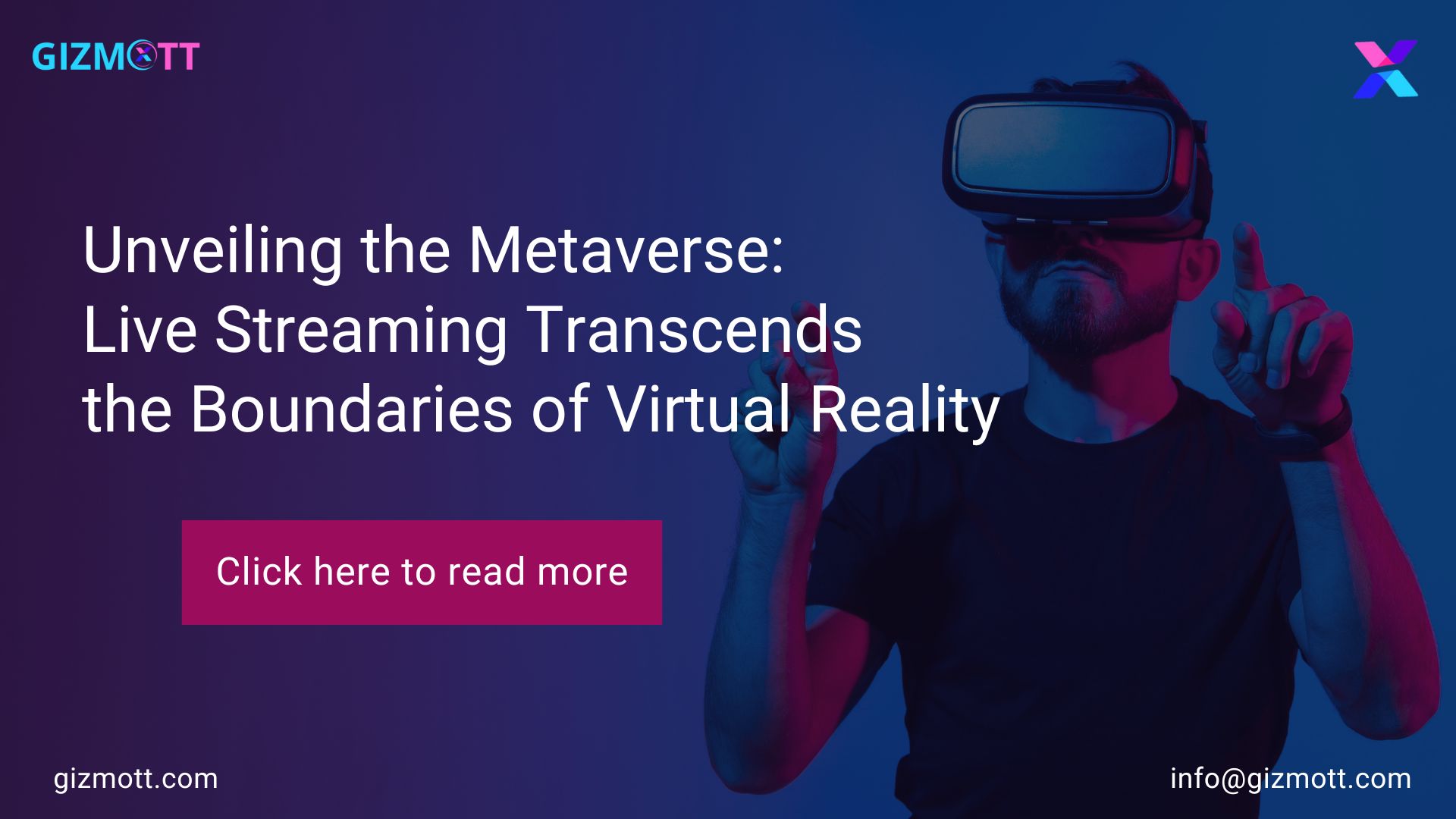The concept of the metaverse has gained tremendous traction in recent years, catching the imaginations of computer enthusiasts, gamers, and even average internet users. At its core, the metaverse is a digital domain in which people may interact, explore, and create in a 3D virtual world. While many people link the metaverse with gaming and entertainment, it is critical to understand that its potential extends far beyond simply show-watching.
In this blog post, we’ll look at the revolutionary potential of metaverse live streaming, and how it’s changing how we consume information, connect with people, and experience the world.
Have you ever watched a live stream and wished you could be there in person? Well, now you can, thanks to the metaverse. Live streaming has been a popular form of entertainment for many years, but it is evolving into something more immersive and interactive with the advent of the metaverse.
One of the emerging trends in the metaverse is live streaming, where people can watch and participate in live shows that are hosted in 3D virtual environments. These shows can range from concerts and sports events to gaming and educational sessions.
Unlike traditional live streaming, where viewers are passive spectators, metaverse live streaming allows viewers to become active participants. They can choose their own avatars, explore the virtual venues, chat with other viewers and the hosts, and even influence the outcome of the show.
Metaverse live streaming is more than just watching shows in a 3D virtual world. It’s a way of making and sharing memories with others across time and space. It’s a way of showing who you are and finding your tribe. It’s a way of learning new things and discovering new opportunities. It’s a way of having fun and being entertained in a fresh and exciting way.
Metaverse live streaming is still pretty new, but it’s growing fast and changing the game of entertainment and social media. As technology gets better and more platforms pop up, we can expect to see more awesome and diverse forms of metaverse live streaming that will suit different tastes and needs.
What is the metaverse?
The metaverse is a term that describes a collective virtual space that connects physical and digital realities. It is not a single platform or application, but rather a network of interconnected digital spaces that can be accessed through various devices, such as smartphones, computers, virtual reality headsets, or augmented reality glasses.
The metaverse allows users to create and explore immersive content, such as games, art, music, education, socializing, shopping, and more. Some of the key technologies that enable the metaverse are:
Virtual reality (VR): VR is a technology that creates an immersive 3D environment that simulates reality. Users wear VR headsets that track their head movements and display stereoscopic images that create a sense of depth and presence.
VR also uses controllers, gloves, suits, or other devices that track the user’s body movements and provide haptic feedback. VR can create realistic or fantastical worlds that users can explore and interact with.
Augmented reality (AR): AR is a technology that overlays digital information or objects onto the physical world. Users can see AR content through smartphones, tablets, glasses, or other devices that have cameras and sensors. AR can enhance the user’s perception of reality by adding useful or entertaining elements, such as directions, animations, filters, or games.
Blockchain: Blockchain is a technology that creates a decentralized ledger of transactions that are verified by a network of nodes. Blockchain enables peer-to-peer transactions without intermediaries or central authorities.
Blockchain can also create digital assets that are unique, scarce, and verifiable, such as non-fungible tokens (NFTs). NFTs are digital representations of anything from art to music to collectibles that can be owned and traded on the blockchain.
Web3: Web3 is a term that refers to the next generation of the internet that is powered by blockchain and other decentralized technologies. Web3 aims to create a more open, fair, and secure internet that respects the user’s privacy and sovereignty. Web3 also enables cross-platform interoperability and compatibility among different applications and devices.
The Evolution of Live Streaming
The rise of live streaming has changed the way we interact with content. Platforms such as Twitch and YouTube have transformed regular people into content creators while also allowing viewers to actively participate through live conversation and interactions.
The metaverse elevates this experience by immersing users in a fully interactive, 3D world, resulting in a seamless blend of live entertainment, gaming, and social engagement.
Redefining Media Consumption
Metaverse live streaming liberates users from the constraints of traditional media consumption. Instead of passively watching a performance or event on a screen, people can become active participants in the experience.
Individuals attending virtual concerts, athletic events, or conferences can personalise their virtual presence, communicate with performers, and engage with other attendees in real time. The metaverse ushers in a new era of immersive entertainment in which the lines between the virtual and physical worlds blur.
Social Connection and Collaboration
The metaverse is about more than just watching stuff; it’s about making relationships and cooperating with like-minded people. Users can congregate in virtual areas, engage with avatars, and communicate via voice or text chat by utilizing metaverse live streaming.
This new layer of social engagement crosses geographical boundaries, allowing people from all over the world to connect, share experiences, and form important bonds.
Empowering Creativity and Expression
Individuals can release their creativity and express themselves in unexpected ways thanks to the metaverse. Content creators can construct virtual worlds, offer unique experiences, and ask audiences to actively participate in their works by live streaming in the metaverse.
Artists, artists, and performers may push their profession to new heights by integrating virtual and physical aspects to offer fascinating and immersive performances that transcend traditional artistic media.
Opportunities for Business and Commerce
Live streaming in the Metaverse opens up new prospects for enterprises and trade. Virtual showrooms can be created by brands to allow customers to examine products in a visually appealing and interactive environment. Virtual conferences and trade exhibits can be hosted by businesses, bringing together specialists from various industries on a worldwide scale.
Furthermore, the metaverse can be used as a platform for virtual marketplaces, where users can buy, sell, and exchange virtual commodities and assets, blurring the distinction between the physical and digital worlds even further.
What are the advantages and disadvantages of live streaming in the metaverse?
Live streaming in the metaverse can offer several benefits and drawbacks for both streamers and viewers. On one hand, it can enhance the seamlessness of remote work by allowing users to interact in a 3D virtual environment that can mimic the physical workplace. It can also create more immersive and interactive experiences by providing users with a realistic and captivating way to watch and participate in shows, events and activities.
Moreover, it can reach new markets and audiences by enabling content creators, distributors and broadcasters to access new segments of users who are interested in the metaverse and its possibilities. Furthermore, it can innovate and experiment with new forms of content by offering more creative freedom and flexibility for content creators, distributors and broadcasters to produce and deliver unique and original content that can appeal to different tastes and needs.
On the other hand, it can require high-end devices and internet connection to ensure a smooth and seamless experience. Users who do not have access to these resources may face technical issues or lag that can affect their enjoyment and participation.
It can also raise privacy and security concerns by exposing users to potential data breaches, cyberattacks or identity theft. Additionally, it can pose ethical and social challenges by creating a digital divide, fostering addiction or escapism or affecting mental health.

How does metaverse live streaming help content creators, distributor, broadcaster, etc.?
Metaverse live streaming can benefit content creators, distributors and broadcasters by providing them with new ways to engage their audiences, monetize their content and create immersive experiences.
Content creators can use the metaverse to showcase their talents, interact with their fans and collaborate with other creators. For example, a musician can perform a live concert in the metaverse, where they can sell tickets, merchandise and virtual goods to their fans.
Distributors can use the metaverse to reach new markets, offer personalized recommendations and create loyalty programs. For example, a streaming service can offer exclusive access to metaverse live streams of popular shows, movies and events to their subscribers.
Broadcasters can use the metaverse to enhance their production quality, offer interactive features and attract more viewers. For example, a news channel can broadcast a live report from the metaverse, where they can show 3D graphics, polls and comments from the audience.
How to create and monetize your own metaverse live streaming content
The metaverse is the next evolution in social connection and the successor to the mobile internet. It is a set of digital spaces that you can move seamlessly between, where you can socialize, learn, play, and more. It is also a new frontier for live streaming, where you can create and share immersive and interactive experiences with your audience.
To create your own metaverse live streaming content, you will need some tools and platforms that enable you to design, build, and publish your effects and experiences. Some of the most popular ones are Spark AR, Moralis, and Unity.
You should also have a clear goal and audience for your content, and design it accordingly. You should also test your content on different devices and platforms to ensure optimal performance and compatibility.
To monetize your metaverse live streaming content, you will need some strategies and methods that allow you to generate revenue from your effects and experiences. Some of the most common ones are advertising, subscriptions, donations, NFTs, tokens, and events.
You should also have a clear value proposition for your content, and market it accordingly. You should also engage with your audience and provide them with feedback and support.
What are some examples of metaverse live streaming platforms?
There are many platforms and applications that enable metaverse live streaming in different ways. Some of them are:
Meta Quest 2: Meta Quest 2 is a VR device that lets users access and create content in the metaverse. Meta Quest 2 has a built-in feature called Live Overlay that allows users to live stream their VR experiences to Facebook Live or Twitch with their real face overlaid onto their VR avatar. Users can also see their viewers’ comments and reactions on their VR headset while live streaming.
Bigscreen: Bigscreen is a VR application that lets users watch movies, TV shows, or videos with friends or strangers in virtual cinemas or living rooms. Bigscreen also allows users to live stream their desktop screens to others in VR or watch live streams from others in VR.
Wave: Wave is a VR application that lets users create and attend live concerts in virtual venues with interactive visuals and sound effects. Wave also allows users to live stream their concerts to platforms like YouTube or Twitch or watch live concerts from others in VR.
Rec Room: Rec Room is a VR application that lets users create and play games with friends or strangers in virtual rooms or worlds. Rec Room also allows users to live stream their games to platforms like YouTube or Twitch or watch live streams from others in VR.

How will live streaming shape the future of the metaverse and online entertainment?
Live streaming in the Metaverse is much more than just viewing TV in a 3D virtual world. It signifies a fundamental shift in how we consume media, interact with people, and perceive our surroundings. The metaverse provides a revolutionary digital landscape with unlimited possibilities by combining entertainment, social engagement, and innovation.
Metaverse live streaming is still in its early stages, but it has the potential to revolutionize the entertainment industry and the way we consume and create content. As technology advances and more platforms emerge, we can expect to see more diverse and innovative forms of metaverse live streaming that will cater to different tastes and preferences.
Metaverse live streaming is not just a trend, but a new medium that will shape the future of entertainment and social interaction.



